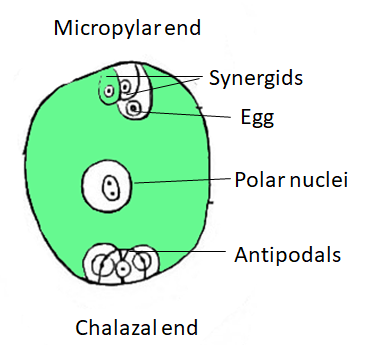
A mature embryo sac in a flowering plant possess 7-cells, but 8 nuclei. Explain with the help of diagrams only.
Answer
500.4k+ views
Hint: All the cells of the embryo sac are haploid except the central cell which becomes diploid because of the fusion of polar nuclei. The haploid sperm and haploid egg combine to make a diploid zygote, the method being called syngamy.
Complete answer:
In an embryo-sac three cells are joined together at the micropylar end and form the egg apparatus. The egg apparatus is made up of two synergids and one egg cell. The synergids containing cellular thickening at the micropylar tip are known as the filiform apparatus, which plays an important role in guiding the pollen tubes into the synergids. Three cells are at the chalazal end and are known as antipodals. Thus, a normal angiosperm embryo-sac at maturity, though 8-nucleate is 7-celled.
Double fertilization is a complex fertilization mechanism of angiosperms (flowering plants). It involves the joining of a female embryo sac with two male gametes (sperm). It starts when a pollen grain sticks to the stigma of the carpel (the female reproductive structure of a flower). The pollen grain then grabs in moisture and starts to germinate, forming a pollen tube that stretches down toward the ovary through the style. The tip of the pollen tube then enters the ovary and penetrates through the micropylar opening within the ovule. The pollen tube proceeds to release the 2 sperm within the megagametophyte.

Note: The female gametophyte has specifically been termed a megagametophyte. It is additionally called the embryo sac in angiosperms. The large cell of the gametophyte will then become the endosperm, a nutrient-rich tissue that provides nourishment to the developing embryo. The ovary, surrounding the ovules, develops into the fruit, which protects the seeds and should function to disperse them.
Complete answer:
In an embryo-sac three cells are joined together at the micropylar end and form the egg apparatus. The egg apparatus is made up of two synergids and one egg cell. The synergids containing cellular thickening at the micropylar tip are known as the filiform apparatus, which plays an important role in guiding the pollen tubes into the synergids. Three cells are at the chalazal end and are known as antipodals. Thus, a normal angiosperm embryo-sac at maturity, though 8-nucleate is 7-celled.
Double fertilization is a complex fertilization mechanism of angiosperms (flowering plants). It involves the joining of a female embryo sac with two male gametes (sperm). It starts when a pollen grain sticks to the stigma of the carpel (the female reproductive structure of a flower). The pollen grain then grabs in moisture and starts to germinate, forming a pollen tube that stretches down toward the ovary through the style. The tip of the pollen tube then enters the ovary and penetrates through the micropylar opening within the ovule. The pollen tube proceeds to release the 2 sperm within the megagametophyte.

Note: The female gametophyte has specifically been termed a megagametophyte. It is additionally called the embryo sac in angiosperms. The large cell of the gametophyte will then become the endosperm, a nutrient-rich tissue that provides nourishment to the developing embryo. The ovary, surrounding the ovules, develops into the fruit, which protects the seeds and should function to disperse them.
Recently Updated Pages
Master Class 11 Economics: Engaging Questions & Answers for Success

Master Class 11 Business Studies: Engaging Questions & Answers for Success

Master Class 11 Accountancy: Engaging Questions & Answers for Success

Master Class 11 English: Engaging Questions & Answers for Success

Master Class 11 Computer Science: Engaging Questions & Answers for Success

Master Class 11 Maths: Engaging Questions & Answers for Success

Trending doubts
State and prove Bernoullis theorem class 11 physics CBSE

1 ton equals to A 100 kg B 1000 kg C 10 kg D 10000 class 11 physics CBSE

State the laws of reflection of light

One Metric ton is equal to kg A 10000 B 1000 C 100 class 11 physics CBSE

1 Quintal is equal to a 110 kg b 10 kg c 100kg d 1000 class 11 physics CBSE

Difference Between Prokaryotic Cells and Eukaryotic Cells




